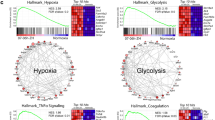Abstract
Hypoxia-induced vascular responses, including angiogenesis, vascular remodeling and vascular leakage, significantly contribute to the onset, development and progression of retinopathy. However, until recently there were no appropriate animal disease models recapitulating adult retinopathy available. In this article, we describe protocols that create hypoxia-induced retinopathy in adult zebrafish. Adult fli1:EGFP zebrafish are placed in hypoxic water for 3–10 d and retinal neovascularization is analyzed using confocal microscopy. It usually takes 11 d to obtain conclusive results using the hypoxia-induced retinopathy model in adult zebrafish. This model provides a unique opportunity to study kinetically the development of retinopathy in adult animals using noninvasive protocols and to assess therapeutic efficacy of orally active antiangiogenic drugs.
This is a preview of subscription content, access via your institution
Access options
Subscribe to this journal
Receive 12 print issues and online access
$259.00 per year
only $21.58 per issue
Buy this article
- Purchase on Springer Link
- Instant access to full article PDF
Prices may be subject to local taxes which are calculated during checkout




Similar content being viewed by others

References
Boutin, A.T. et al. Epidermal sensing of oxygen is essential for systemic hypoxic response. Cell 133, 223–234 (2008).
Cao, Y. Monotherapy versus combination therapy of angiogenic and arteriogenic factors for the treatment of ischemic disorders. Curr. Mol. Med. 9, 967–972 (2009).
Makino, Y. et al. Inhibitory PAS domain protein is a negative regulator of hypoxia-inducible gene expression. Nature 414, 550–554 (2001).
Kondo, T. et al. Knockout of insulin and IGF-1 receptors on vascular endothelial cells protects against retinal neovascularization. J. Clin. Invest. 111, 1835–1842 (2003).
Cao, R., Jensen, L.D., Soll, I., Hauptmann, G. & Cao, Y. Hypoxia-induced retinal angiogenesis in zebrafish as a model to study retinopathy. PLoS One 3, e2748 (2008).
Lee, S.L. et al. Hypoxia-induced pathological angiogenesis mediates tumor cell dissemination, invasion, and metastasis in a zebrafish tumor model. Proc. Natl Acad. Sci. USA 106, 19485–19490 (2009).
Rouhi, P. et al. Pathological angiogenesis facilitates tumor cell dissemination and metastasis. Cell Cycle 9, 913–917 (2010).
Dahl Ejby Jensen, L. et al. Nitric oxide permits hypoxia-induced lymphatic perfusion by controlling arterial-lymphatic conduits in zebrafish and glass catfish. Proc. Natl Acad. Sci. USA 106, 18408–18413 (2009).
Lawson, N.D. & Weinstein, B.M. In vivo imaging of embryonic vascular development using transgenic zebrafish. Dev. Biol. 248, 307–318 (2002).
Gariano, R.F. & Gardner, T.W. Retinal angiogenesis in development and disease. Nature 438, 960–966 (2005).
Fouquet, B., Weinstein, B.M., Serluca, F.C. & Fishman, M.C. Vessel patterning in the embryo of the zebrafish: guidance by notochord. Dev. Biol. 183, 37–48 (1997).
Alvarez, Y. et al. Genetic determinants of hyaloid and retinal vasculature in zebrafish. BMC Dev. Biol. 7, 114 (2007).
Acknowledgements
This study was supported through research grants from the Swedish Research Council, the Swedish Cancer Foundation, the Karolinska Institute Foundation, the Karolinska Institute Distinguished Professor Award, the European Union Integrated Project of Metoxia (Project no. 222741) and the European Research Council (ERC) advanced grant ANGIOFAT (Project no 250021). Z.C. was supported by the Swedish Heart and Lung Foundation.
Author information
Authors and Affiliations
Contributions
Y.C. designed the study. L.D.J., P.R. and Z.C. performed the experiments. L.D.J., P.R., Z.C. and Y.C. analyzed the data. K.H., T.L., J.F.S. and E.W. participated in designing and discussing this study. L.D.J., P.R., Z.C. and Y.C. wrote the article.
Corresponding author
Rights and permissions
About this article
Cite this article
Cao, Z., Jensen, L., Rouhi, P. et al. Hypoxia-induced retinopathy model in adult zebrafish. Nat Protoc 5, 1903–1910 (2010). https://doi.org/10.1038/nprot.2010.149
Published:
Issue Date:
DOI: https://doi.org/10.1038/nprot.2010.149
This article is cited by
-
6-Gingerol stabilized the p-VEGFR2/VE-cadherin/β-catenin/actin complex promotes microvessel normalization and suppresses tumor progression
Journal of Experimental & Clinical Cancer Research (2019)
-
High glucose levels affect retinal patterning during zebrafish embryogenesis
Scientific Reports (2019)
-
Retinal Degeneration and Regeneration—Lessons From Fishes and Amphibians
Current Pathobiology Reports (2017)
-
Animal Models of Diabetic Retinopathy
Current Diabetes Reports (2017)
-
Invasiveness and metastasis of retinoblastoma in an orthotopic zebrafish tumor model
Scientific Reports (2015)
Comments
By submitting a comment you agree to abide by our Terms and Community Guidelines. If you find something abusive or that does not comply with our terms or guidelines please flag it as inappropriate.


